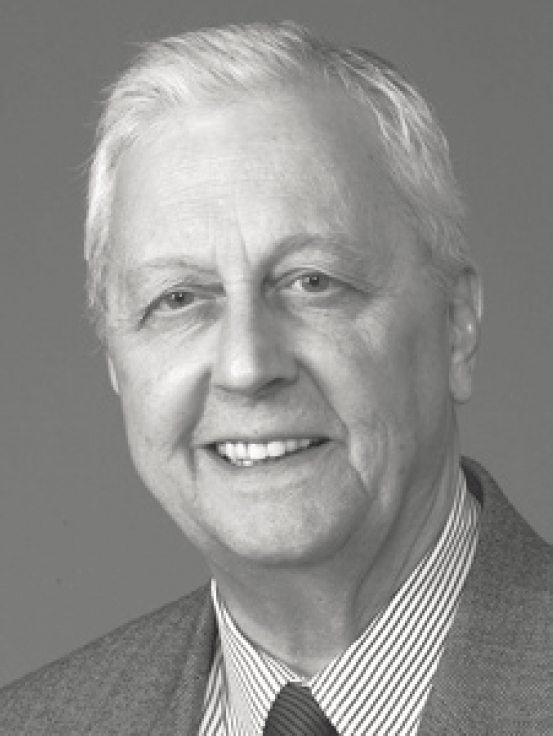ROBERT W. FARQUHAR
1932–2015
Elected in 2012
“For deep space missions to asteroids and comets and for leading the NEAR mission to Eros.”
BY DAVID M. VAN WIE
ROBERT WILLARD FARQUHAR, a national expert in deep-space mission and trajectory design and executive for space exploration at KinetX Aerospace, died October 18, 2015, at the age of 83.
He was born Robert Greener on September 12, 1932, in Chicago, where he was raised by his mother Ruth C. Boyens Greener (after her divorce) with support from his grandmother, Rose Boyens. His mother married Frank Farquhar when Bob was 13 years old, and Bob took on the surname in high school after he was formally adopted by Frank.
Before college, Bob joined the Army and served in Japan and Korea during the Korean War. Upon returning, he attended the University of Illinois Chicago, where, pursuing his longstanding interest in aviation, he earned his bachelor’s degree in aeronautical engineering in 1959. He worked briefly on interplanetary trajectories at the RAND Corporation before going on to get his engineering master’s degree (1961) at the University of California, Los Angeles, and—after working at Lockheed Missiles and Space Company in Sunnyvale—a PhD in astronautics (1968) at Stanford University.
Bob married the former Bonnie Gail Johnson and they had a daughter, Patricia Lee. Bonnie died in 1992. In 2004 Bob married Irina (Irene) Vostokova and they had a daughter, Anna (Anya).
Building on his PhD work studying the use of libration orbits, Bob is credited with coining the term halo orbit for the class of periodic three-dimensional orbits that exist near Lagrange points in three-body orbital mechanics. Throughout his career, he maintained a strong interest in mission and novel trajectory design for missions to the Moon, libration points, comets, asteroids, and planets.
After obtaining his PhD, Bob worked at NASA’s Goddard Space Flight Center (1969–90) and in supporting assignments at NASA headquarters (1978–90). Among his many responsibilities during these years, he served as the flight dynamics manager and flight director for the International Sun-Earth Explorer 3 (ISEE-3) mission, which was the first mission to a libration point. It was renamed the International Cometary Explorer (ICE), and the spacecraft made a textbook pass through the tail of comet Giacobini-Zinner on September 11, 1985. Bob was also instrumental in creating the NASA Discovery Program, which is aimed at modest cost for solar system explorations missions.
He joined the Johns Hopkins University Applied Physics Laboratory (JHU/APL) in 1990 and worked there until 2007. He was mission director for the Near-Earth Asteroid Rendezvous (NEAR) Shoemaker mission that intercepted, explored, and, following his intricately designed trajectory, successfully landed on 433 Eros; the MESSENGER (Mercury Surface, Space Environment, Geochemistry and Ranging) mission, the first to orbit and conduct an extensive exploration of Mercury; and New Horizons, the first mission to Pluto and its moon Charon.
Bob left JHU/APL to serve as the Charles A. Lindbergh Chair for Aerospace History at the National Air and Space Museum in Washington (2007–08). In 2008 he joined KinetX as executive for space exploration, focusing on the development of new architectures for human spaceflight beyond low Earth orbit (LEO). These architectures envisioned reusable vehicles, deep-space habitats, libration-point staging, and an innovative phasing-orbit rendezvous (PHOR) technique. Bob was driven to find economically realistic ways to carry out human missions in deep space.
In service to the National Academies, he was a member of the Committee on Priorities for Space Science Enabled by Nuclear Power and Propulsion: A Vision for Beyond 2015 (2004–06).
Over his career, he received awards and honors too numerous to mention. They include the Mechanics and Control of Flight Award (1981) from the American Institute of Aeronautics and Astronautics (AIAA), the Dirk Brouwer Award (1984) from the American Astronautical Society (AAS), a letter of commendation from President Ronald Reagan (1984), a NASA Medal for Exceptional Engineering Achievement (ISEE-3/ICE) (1988), the Space Pioneer Award from the National Space Society (2001), the Diplôme d’Honneur (2001) from the Fédération Aéronautique Internationale, the 2002 Laureate Award for Space from Aviation Week & Space Technology, the NASA Medal for Exceptional Engineering Achievement (NEAR) (2002), and the Grainger College of Engineering Alumni Award for Distinguished Service (2013). In addition to his NAE election in 2012, he was elected to the AAS (1986), International Academy of Astronautics (1996), and AIAA (2004). Asteroid #5256 was named Farquhar in his honor in 1988.
Bob was a prolific writer in the space exploration community, with over 200 publications. His book Fifty Years on the Space Frontier: Halo Orbits, Comets, Asteroids, and More (Outskirts Press, 2010) provides unique insights into his efforts and contributions.
In parallel with his passion for space exploration, Bob compiled an exhaustive world-class collection of stamps from Manchuria and Manchukuo over a 50-year span. A portion of his collection was documented in his book Manchuria in Transition 1925–1934: Chang Tso-lin to Emperor Kang Teh (John Bull Stamp Auctions and Causeway Bay Post Office, 2006).
Family was hugely important to Bob. He suggested to the discoverers of minor planet 5947 that it be named after his first wife and it was subsequently named 5947 Bonnie in her memory. And on Valentine’s Day in 2000, he persuaded the International Astronomical Union to name an asteroid after the woman who became his new wife: it is named 5957 Irina.
In addition to Irene, Bob is survived by their daughter Anna and four grandchildren. He was predeceased by his first wife and by his daughter Patricia Lee, who died in 2011.







